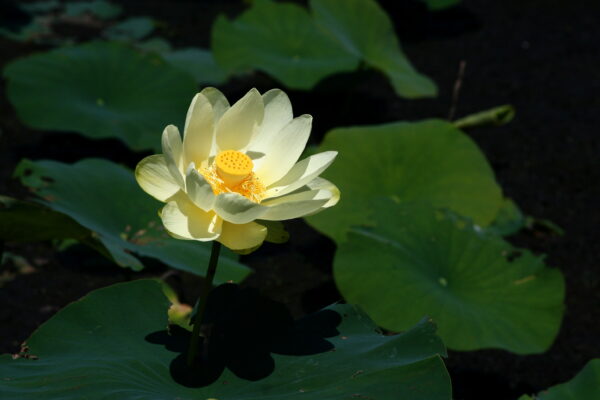American Lotus

Species at a Glance
The American lotus is an aquatic perennial plant with large round leaves, luminescent yellow flowers, and distinctive cone-shaped seed pods. The name American lotus means “sacred bean” after the seed pods, which are popular in dried floral arrangements. Unfortunately, this fast-growing species is also a strong colonizer that can quickly dominate and negatively impact a water body.
Species Description
The American lotus is an emergent, aquatic perennial with distinct leaves, flowers, and seed pods that make it easy to identify. The leaves are large, circular, and can be found either floating on the water’s surface, or elevated several inches above the water on long stiff stalks. The undersides of the leaves may be slightly hairy and the stem attaches to the center of the leaf. While it may be confused with water lilies, the circular leaves of American lotus do not have slits in them. The flowers are large and luminescent yellow growing up to 20cm (8 in) wide and containing many petals. The seed pods of American lotus are large, cone-shaped, and contain many large brown seeds.
Native & Introduced Ranges
While it’s considered native to eastern and central North America from Maine to Wisconsin and southward from Florida to Texas, the Pennsylvania Department of Conservation and Natural Resources has listed the American lotus as a non-native and invasive species. In Pennsylvania, American lotus has been introduced into Lake Wilhelm in Mercer County, Wildwood Lake in Dauphin County, and in Pymatuning Reservoir in Crawford County, with additional sightings in eastern and north-western Pennsylvania counties.
Biology & Spread
The American lotus is popular in the pond and water garden trade and has been rapidly expanding its local distributions, as quickly as 15m (50 ft) per year in some areas. For example, American lotus was introduced into Pymatuning Reservoir in 1998 and by 2007 had dominated more than half of the shoreline in the northern portion of the reservoir.
Seeds, rhizomes, and tubers all facilitate its movement and spread. Rhizomes are slender stems that creep along the muddy bottom and sprout new plants that can form into large colonies. Tubers are projections of the stems from which new buds can arise. The American lotus flowers from May through August and the hard-coated seeds can remain viable for decades.
Habitat
Preferring still water, the American lotus is typically found in shallow, muddy ponds, lake margins, rivers, human-altered habitats, and in shallow water no more than 2m (6 ft) deep. It tolerates a wide range of pH and soil conditions, but prefers full sun, loamy soils, and plenty of space.
Impacts
Threat to Biodiversity
American lotus forms dense canopies over the shallow margins of lakes and rivers which can restrict water movement, impact water quality, and block sunlight from entering the water column. Floating and emergent leaves add little oxygen to the water column during photosynthesis, resulting in lower oxygen concentrations within American lotus beds versus uninvaded open water locations. The hypoxic conditions found under American lotus leaves reduces the amount of available habitat for fish and other aquatic organisms. Research also suggests that American lotus may produce toxic chemical agents that, in combination with the shade produced by the large leaves, prevents the growth of other submerged native plants trying to grow beneath.
Economic Costs
Colonies of American lotus can make recreational boating nearly impossible as its large leaves impede movement and its thick, rope-like stems entangle on boat propellers. Recreational fishing is also threatened as the low-oxygen conditions created by American lotus result in very few fish found within infested areas. Annually, Pymatuning State Park staff treat American lotus with herbicide, focusing on open channels and large patches in order to keep them from expanding. In some areas, such as Wildwood Park in Dauphin County, American lotus is being maintained for the shallow wetland habitat it provides for egrets and other wading birds.
Prevention & Control
Once established, American lotus can be very difficult to control. It can be cut and removed, but this is only a temporary solution as it can quickly reestablish from seeds and rhizomes. Some chemicals have been successful at treating American lotus; however, decomposition of the dead plant material may cause further oxygen depletion and fish kills.
The best way to manage American lotus is to prevent its spread into new areas.
- Always check for and remove plants, mud, and debris from boats, trailers, clothing, and equipment before entering a water body and before leaving a water body.
- Drain all water from bait buckets, bilges, and live wells before transporting to new areas.
- Clean all gear and equipment with hot water or salt water, OR let boats and equipment dry thoroughly for at least five days before entering a new water body.
- When choosing plants for a pond or water garden, purchase from a licensed nursery and choose regionally-native or non-invasive plants. Check with your state natural resource agency to confirm which plants to avoid for your region.
References:
- Block, T. A. and Rhoads, A.F. 2011. University of Pennsylvania Press.
- Pennsylvania Department of Conservation and Natural Resources. 2017. Proposed rulemaking 17, PA. Code CH. 45.
- Conservation of Pennsylvania Native Wild Plants. Pennsylvania Bulletin.
- Texas A&M AgriLife Extension. American Lotus. Aquaplant: A pond manager diagnostic tool.
- University of Florida Center for Aquatic Invasive Plants. Nelumbo lutea. Online fact sheet.



